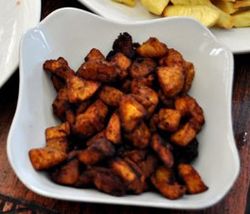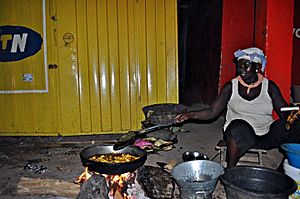Fried plantain facts for kids

Fried plantain is a super popular dish enjoyed in many parts of the world! You can find it wherever plantains grow, like in West Africa, East Africa, Central America, northern South America, and the Caribbean countries. It's also a big hit in many parts of Southeast Asia, where people love fried snacks.
Plantains look a lot like bananas, but they are usually cooked before eating. Fried plantain can be called different names depending on where you are. For example, it's called alloco in Côte d'Ivoire and dodo in Western Nigeria. In Ghana, a spicy version is called kelewele. In places like the Dominican Republic, Cuba, and Puerto Rico, people often slice plantains, fry them, smash them flat, and then fry them again! These are known as patacones or tostones.
Contents
How People Enjoy Fried Plantain
Fried plantain is super versatile! You can eat it as a quick snack, a tasty starter before a meal, or as a side dish with your main course. Imagine having it with Jollof rice, spicy grilled meat, tomato stew, or beans.
People prepare fried plantain in many ways. Sometimes it's salted, sometimes unsalted. It can be cut into "ears," "fingers," diced into small cubes, or even fried whole. In Central America and the Caribbean, sweet yellow plantains are often fried in hot oil. They are sometimes served with sour cream, ketchup, or a mix of mayonnaise and ketchup.
Alloco: A West African Treat
Alloco is a famous fried plantain dish from Côte d'Ivoire and Burkina Faso. It's known as dodo in Nigeria, missolè in Cameroon, and makemba in the Democratic Republic of the Congo. The name alloco comes from the Baoulé people in Côte d'Ivoire. It means a ripe plantain.
This yummy West African snack is made from fried plantain. It's often served with spicy chili pepper and onions. In Nigeria, it can be a side dish or eaten all by itself. There's even a dish called Gizdodo in Nigeria, which mixes fried plantain with grilled gizzard.
Alloco is so popular that it's often sold as fast-food on the streets of Côte d'Ivoire. There's even a place in the Cocody neighborhood called Allocodrome, named after this dish, where many vendors sell grilled meat and alloco.
Making Alloco: A Simple Recipe
To make alloco, you need plantains that are just right – not too green and not too soft. The best plantains for alloco are a bit yellow with some black spots. Alloco is traditionally fried in either peanut oil or palm oil, depending on the area in Côte d'Ivoire.
Here's how it's generally made:
- First, peel the plantains.
- Then, cut them lengthwise and then into smaller pieces.
- Heat up some oil in a saucepan.
- Once the oil is hot, carefully place the plantain pieces in.
- Fry them until they turn a golden or reddish-brown color.
- Take the plantains out and put them on paper towels to soak up extra oil.
- In a little bit of the leftover oil, fry some onions and peppers for a few minutes.
- Finally, add the plantains back in with a splash of water, cover the pan, and let them simmer for a bit.
Serving Alloco
Alloco is usually served as a side dish with a bigger meal or another snack. You might see it served with fresh fish or even some boiled eggs. It often comes with a spicy sauce called sauce de piment to add an extra kick!
Kelewele: Ghana's Spicy Plantain
 |
|
| Type | Snack |
|---|---|
| Place of origin | Ghana |
| Main ingredients | Plantains, spices |
Kelewele is a very popular Ghanaian food made from fried plantains seasoned with delicious spices. In English, it's sometimes called "hot plantain crisps." In Accra, kelewele is often sold at night by street vendors. It's also a popular choice for dinner.
Kelewele originally comes from Ghana. It has become well-known in America thanks to various recipe books.
Making Kelewele
To make kelewele, the plantains are peeled and can be cut into chunks or cubes. The main spices used are ginger, cayenne pepper, and salt. Sometimes, people also add onions, anise, cloves, nutmeg, cinnamon, and chili powder for extra flavor.
It's important that the oil is hot when frying. Also, the plantain shouldn't be too soft, or it will soak up too much oil. The plantain should be fried until the sugar inside it caramelizes. This gives the plantain nice brown edges.
Serving Kelewele
Kelewele can be served with bean stew, peanuts, or simply enjoyed on its own as a dessert.
Images for kids





